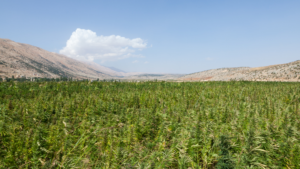It is said that hemp has over 25,000 uses!
Hemp is the most versatile plant we have on the planet. Every part of the plant from the seeds, husk, fibre & leaves can be used for a variety of things ranging from highly nutritional food to plastic and everything in between.
Hemp is easy to grow almost anywhere in the world in any climate, in all soil conditions, matures in a few months and can grow without the use of pesticides and herbicides. Hemp actually absorbs CO2 from the air and purifies the soil it grows in from toxins.
Yes this is real! Hemp is truly a miraculous plant and now we are finally starting to realise this once again.
By harnessing the power of hemp we can create a healthier, happier population and planet.
Continue reading to learn 8 of the most incredible uses of hemp.
1. Food
The seeds of the hemp plant provide an incredible source of food for humans. The seeds are high in fibre, protein and omega 3 fatty acids and can be eaten raw, cooked or roasted.
Hemps seeds can be eaten as they are or hulled into hemp hearts. Hemp seeds can be used to sprinkle on top of almost anything sweet or savoury like smoothies, salads and it baking. They have a delicious nutty flavour. Hemp seeds can also be used to make hemp oil, flour, protein powder and milk.
Hemps seeds are a complete protein meaning it contains each of the nine essential amino acids necessary in the human diet. The seeds alone contain 20-25% protein and hemp protein powder, which has had the oil extracted is 50% protein! Hemp protein is easy to digest and high bioavailability.
They also have the perfect ratio of 3:1 omega 6s to omega 3s and just one tablespoon of hemp oil contains 95% of the daily recommended intake of omega 3s and is low in unsaturated fat. Hemp oil contains 50% less saturated fat than olive oil.
Hemp oil also contains potassium, copper, vitamin A, vitamin B1, vitamin B3, vitamin B5, vitamin B9, and chlorophyll.
Including hemp seeds in your diet can boost your immune system, promote healthy hair, skin and joints, reduce your risk of heart disease and aid in digestion. Plus they are abundant and cheap to source.
2. Fabric
Fibre from the stems of the hemp plant is used to weave fabric. Hemp fibre has been used to make fabric for thousands of years. In fact in recent history most clothing and other materials like rope were made out of hemp. The only reason the hemp fabric industry almost disappeared entirely was because of the prohibition of hemp in the 1970s as a result of the war on drugs. Even though hemp has no psychoactive effect at all.
Hemp fibre is highly versatile. It can be used to make blankets, bedding and linen, carpet, rope, nets as well as textiles for clothing.The popularity of clothing made out of hemp is starting to take off as countries like America, Australia, Canada, India and New Zealand. start to loosen their laws on the cultivation of hemp.
The fabric that is made from hemp is durable, breathable and warm. It gets softer with use, it wears in instead of wearing out. It is also mould resistant, antibacterial and much better for the environment than cotton and other synthetic fabrics which are land and water intensive, require the use of harsh chemicals to produce and clog up our landfills. Hemp also absorbs a tonne of carbon dioxide from the air, 5 tonnes per acre to be exact.
Hemp clothing has long been associated with dirty hippies wear scratchy brown sacks! But today there are so many amazing brands defining the fashion hemp industry producing beautiful clothes for everyone.
3. Skincare & Cosmetics
Hemp oil dramatically decreases dryness, alleviates itching and irritation and has high anti-inflammatory properties.
Hemp oil is perfect for all skin types, including acne prone skin, because it can help moisturise without clogging pores.
It can also help regulate oil production while providing optimal hydration.
The powerful anti-inflammatory effects of omega 6 fatty acid, and GLA (Gamma Linolenic Acid) found in Hemp Oil, help soothe the skin and encourage new skin growth and cell regeneration.
Hemp Oil is also proven to reduce fine lines and wrinkles.
4. Construction Materials
The hurd, also known as shiv, of the hemp plant can be used to make construction material, known as hempcrete.
Hempcrete is a hemp-lime composite material and can be used for fibreboard, fibreglass, cement, insulation, mortar and compost. It is made from the hemp hurds mixed with a lime-based binder and water. Hemp hurds have high silica content which allows it to bind to the lime with the same strong bonds found in cement.
Hempcrete is only about 15% as dense as concrete, cured hempcrete will even float in water! While this means hempcrete needs a frame that supports vertical load the significant portion of trapped air makes it a good insulator.
It is breathable but also insulates for heat and sound, it isn’t brittle, is lightweight and easier to work with that other lime mixtures.
Hempcrete is resistant to mould and fire to top it all off!
5. Paper
Yes you can make paper out of hemp!
In fact the first paper that was ever made in China over 2,000 years ago was made out of hemp. From there hemp paper eventually spread to the Middle East and America. The first and second drafts of the Declaration of Independence were written in hemp paper in 1776!Hemp paper was widely used across the world in the 1800s, but declined in the early 1900s as hemp production started to become restricted due to big textile, newspaper and oil companies lobbying to prohibit its cultivation.
Hemp paper is made from the hurd and is much more suitable for paper than trees due to its higher cellulose content. It produces stronger paper that is resistant to deterioration, it uses much less land than trees and grows so much faster.
1 acre of hemp produced the same amount of paper as 4-10 acres of trees over a 10 year cycle. Hemp stalks also grow to maturity in 4 months while trees take 20-80 years! This means that the use of hemp paper will help to support the fight against deforestation.
Hemp toilet paper is also an amazing sustainable alternative to regular toilet paper!
We have a long way to go before we see the hemp paper industry take over the regular paper industry in terms of raw materials and technology but we are making steps towards the right direction.
6. Plastic
Hemp is an incredible alternative to plastic made out of polluting and non-renewing plastic made from petrochemicals.
Plastic are used in almost all aspects of our life. These materials are used in everything from countertops to pens, toothbrushes, computers, radios, light fittings, TVs and the list goes on. Plastic is non biodegradable meaning every piece of plastic ever made still exists, which is a huge issue for our environment and for our health.
But hemp is coming to the rescue! The basic building block of plastic is cellulose which is found in high quantities in hemp stalks. This makes hemp an incredible source of renewable and 100% biodegradable, plant derived plastic. Recent advances in technology have found ways to create plastic using hemp and cornstarch which is very strong and highly malleable. Hemp hurds can be used to make cellophane wrap. Hemp can also be used to produce resin which can be used to make instruments, furniture and other electrical appliances.
Hemp can also be made into compressed door panel and dashboards. These composites are less expensive than dangerous fibreglass counterparts.
This is nothing new though! Henry Ford famously made a car out of hemp fibreglass in 1941. The hemp panels were 10 times stronger than steel and much lighter. His car was also run on hemp ethanol fuel.
7. Fuel
Hemp can be used to make biofuel that is clean and renewable. Biofuel is fuel that is derived from living matter like plants.
Fuel produced by fossil fuels are non-renewable and release toxins into the air that pollute our air and water.
Hemp can be turned into biodiesel and bioethanol that can power both diesel and petrol cars (which is what Henry Ford used to power his hemp car!).
Even hemp that has been contaminated by removing toxins from the environment can be used to produce biofuel.
To turn hemp into fuel, first of all the plant is shredded and heated with chemicals that release the cellulose. Enzymes are then used to break down the cellulose into sugars. Microbes are then added to aid in the fermentation of the sugars which eventually turns into ethanol. The ethanol is then purified and distilled, leaving the final biofuel
8. CBD Oil Extract
Almost all strains of Cannabis contain CBD including hemp. CBD is found in the stems, flowers and leaves of the plant and are usually extracted with a solvent solution such as ethanol. CBD can be used to treat a wide variety of mental and physical health condition naturally.
CBD extracted from industrial hemp is very low in TBC and is non-psychoactive.
Learn more about CBD here.
There you have 8 uses for hemp!
Hemp is the most versatile plant on the planet. There are many more uses for hemp not mentioned in this article.
There isn’t much that hemp can’t do…





